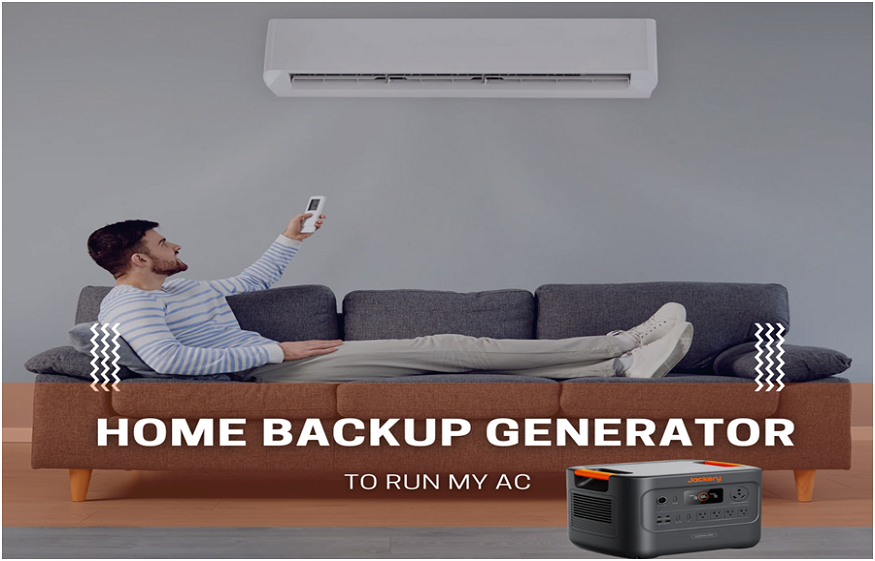Power outages. They’re more than just an inconvenience; they can disrupt our entire lives, especially in the US, where extreme weather events and grid vulnerabilities are increasingly common. Imagine a sweltering summer day with your AC suddenly cutting out, or a cold winter night without heat. Beyond discomfort, a lack of power can lead to spoiled food, disabled medical equipment, and even compromised safety.
But what if you could take control of your home’s power supply? I mean, investing in a reliable home backup power generator? By providing uninterrupted power, a good backup system ensures your essential appliances, from your refrigerator to critical medical devices like oxygen machines or CPAPs, continue to run seamlessly.
In this guide, we’ll explore how to choose the best home backup generator to keep your AC running and your home comfortable, no matter what the grid throws your way.
AC’s Power Needs: Starting vs. Running Watts
When it comes to powering your air conditioner with a home backup generator, not all watts are created equal. You’ll encounter two crucial terms: running watts and starting watts. Understanding the difference between these is crucial for selecting a generator that can meet your AC’s demands without tripping or failing.
- Running watts refer to the continuous power your AC unit needs to operate once it’s already on and humming along. This is the steady power draw that keeps the compressor and fan working.
- Starting watts, on the other hand, represent the brief, higher surge of power your AC requires for a fraction of a second when it first kicks on. This initial “startup” surge is necessary to overcome the inertia of the motor and get the compressor running. Think of it like pushing a heavy cart – it takes more effort to get it moving than it does to keep it rolling.
Typical AC Power Requirements:
To give you a general idea, here’s what you can expect from common AC types:
- Window AC Units: These smaller units typically require 500 to 1,500 running watts. However, their starting watts can be 2 to 3 times higher than their running watts.
- Central AC Units: As you might expect, central air conditioning systems are much more power-hungry. They generally need 2,000 to 5,000 running watts. Crucially, their startup surge can be significantly higher, sometimes three or more times their running wattage.
Let’s look at some practical examples to illustrate the difference:
A 10,000 BTU window AC unit might have a running wattage of approximately 1,200W. However, when it first cycles on, it could demand a starting wattage of around 3,600W. If your generator can only provide 2,000 running watts and 2,500 starting watts, it simply won’t be able to handle this AC’s startup.
For a typical 3-ton central AC unit, you might see a running wattage of around 3,500W. But be prepared for a starting wattage that could jump to 10,000W or even more. This is why a robust backup power source is essential for central air.
Don’t Guess – Check Your AC’s Label!
While these examples provide a good starting point, the most accurate way to determine your specific AC’s power requirements is to check its label or consult the owner’s manual. Look for terms like “rated wattage,” “running watts,” or “maximum power input.” If only amperage is listed, you can calculate wattage using the formula:
Watts = Amps x Volts
For example, if your AC draws 10 amps at 120 volts, its running wattage would be 1,200W. Remember to also look for information on surge or starting currents. This crucial step will ensure you choose a home backup generator perfectly matched to your AC’s needs, preventing frustration and ensuring reliable cooling when you need it most.
Look into Your Home Backup Generator Options
When it comes to safeguarding your home against power outages, you have several primary options. Understanding these differences is crucial for making an informed decision that aligns with your needs and priorities.
Portable Generators (Gas/Propane)
These are often the most affordable upfront option. Portable generators typically run on gasoline or propane and are designed for temporary, on-demand power.
Pros
Generally lower initial cost, readily available, and can be used for various purposes beyond home backup (e.g., camping, job sites).
Cons
Can be very noisy during operation, require a constant supply of fuel which needs to be stored safely, emit harmful fumes (meaning they must be used outdoors and away from windows), and require manual setup each time there’s an outage. Refueling can be inconvenient, especially during bad weather or prolonged outages.
Home Battery Backups (Solar/Lithium)
Representing a more modern and increasingly popular solution, home battery backup systems store electricity for later use. Many can be integrated with solar panels, creating a “solar generator” system.
Pros
Low Maintenance: With fewer moving parts compared to fuel-based generators, they require minimal ongoing maintenance.
Automatic Transfer (with switch): When connected to your home’s electrical system via a smart transfer switch, they can detect an outage and seamlessly kick in, providing uninterrupted power.
Energy Independence & Savings: By charging with solar or during off-peak electricity hours, you can reduce your dependence on the grid and potentially lower your electricity bills over time.
Versatile Charging: Can be recharged from wall outlets, solar panels, and sometimes even a car.
Although High in Initial Investment, We Still Recommend Lithium Battery
While all options have their place, lithium battery-based generators are increasingly becoming the preferred choice for homeowners looking for a modern and efficient backup solution, particularly for powering essential appliances like AC.
The portability of many lithium battery generators is a significant benefit. While a standby generator is permanently fixed, a portable lithium power station can be moved where needed – whether it’s to power a specific room’s AC during an outage, take on a camping trip, or use for DIY projects around the house.
This versatility adds great value beyond just emergency preparedness. They’re lighter, more compact, and designed for ease of use.
Best Home Battery Backup Setup — Jackery Solar Generator HomePower 3000
Let’s put it frankly. The home backup power can be your lifesaver, especially during power outages. It boasts:
High AC Output: It boasts a continuous AC output of 3600W and a surge output of 7200W. This is sufficient to power most essential household appliances, including refrigerators, coffee machines, washing machine combos, electric ovens, and more.
Large Battery Capacity: With a 3072Wh LiFePO4 battery, it can provide significant backup power. For example, it can power a refrigerator (200W) for 1-2 days or a general household for up to 15 hours.
UPS Functionality: It features an Uninterruptible Power Supply (UPS) with a fast switchover time of less than 20ms. This means that when a power outage occurs, it automatically kicks in to provide power to connected devices with virtually no interruption, which is crucial for sensitive electronics like computers and medical equipment.
Multiple Charging Options: You can recharge the HomePower 3000 in various ways, ensuring it’s ready when you need it:
- AC Charging (wall outlet): Fully recharges in 2.2 hours (1800W).
- AC+DC Charging (hybrid): Fastest option, fully recharges in 1.7 hours (2500W).
- Solar Charging: Can be charged with Jackery 200W solar panels, with a full charge taking around 4-11 hours, depending on the solar input.
- Gas Generator Charging: 2.2 hours.
- Car Charging: Supported.
ZeroDrain™ Technology: This feature allows the unit to retain 95% of its charge even after a full year of inactivity, making it a reliable choice for emergency backup.
Standby Generators
For permanent installations, typically powered by natural gas or propane, and are designed to automatically turn on within seconds of a power outage.
Pros
Provide whole-home backup, automatic operation, and can run for extended periods as long as they have a continuous fuel supply.
Cons
The most expensive option upfront, including installation costs, still produces noise and emissions, and requires professional installation and regular maintenance. They are fixed in place and lack portability.
Maximizing Your Generator’s Efficiency and Runtime
Even with the best home backup generator, intelligent usage can significantly extend its runtime, conserve energy, and ensure your essential appliances, including your AC, stay powered for longer. Here are some key tips to get the most out of your investment:
. Optimize Your AC Settings for Efficiency
AC is a power hog, but small adjustments can make a big difference, especially when running on backup power.
- Utilize Eco Mode or Energy-Saving Features: Many modern AC units come with “eco” or “energy-saver” modes. These modes often cycle the compressor on and off to maintain a comfortable temperature without continuous operation, significantly reducing power draw.
- Set a Higher Thermostat Temperature: Every degree lower on your thermostat increases your AC’s workload and power consumption. Aim for the highest comfortable temperature setting, ideally around 78-80°F (25-27°C) when running on generator power. You might be surprised how comfortable you can be with a slightly warmer setting, especially if your generator keeps the air circulating.
- Use Programmable Thermostats: If you have one, program it to scale back AC usage during periods when you’re not home or actively using the cooled space.
- Supplement with Fans: Ceiling fans and portable fans consume far less power than an AC unit and can make a higher thermostat setting feel more comfortable by creating a wind-chill effect.
. Pair with Solar Panels for Extended Runtime (Especially for Battery Backups)
This tip is particularly relevant for home battery backup systems like Jackery Solar Generators. One of the most significant advantages of these systems is their ability to be recharged by solar energy, offering virtually unlimited runtime as long as the sun is shining.
- Continuous Recharging: Connect compatible solar panels to your battery backup system. During daylight hours, the panels will actively replenish your battery, offsetting the power drawn by your AC and other appliances. This means you can run your AC for much longer than the battery’s standalone capacity would allow.
- Optimal Panel Placement: Ensure your solar panels are placed in an area with maximum direct sunlight exposure throughout the day for the most efficient charging.
. Prioritize Essential Appliances During Outages
While your goal might be to run your AC, a wise strategy during a power outage is to prioritize truly essential appliances to conserve your generator’s capacity and fuel (if applicable) or battery life.
- Make a Priority List: Before an outage occurs, identify your absolute must-have appliances. This usually includes your refrigerator/freezer (to prevent food spoilage), critical medical devices (like the “portable battery operated oxygen machine,” “lithium battery for CPAP,” or “portable generator for dialysis machine” mentioned in your keywords), and perhaps lights, phone chargers, and a fan.
- Avoid Non-Essential Loads: Unplug or turn off appliances that aren’t critical. This includes dishwashers, washing machines, dryers, electric water heaters, desktop computers (unless essential for work/emergency communication), and unnecessary lighting. Even small phantom loads can add up.
- Cycle High-Draw Appliances: If you need to use several high-wattage appliances, try to cycle them. For example, run your AC for a period, then turn it off while you use a microwave or hair dryer, then turn the AC back on. This prevents overloading your generator and ensures power is available for the most critical needs.
Enjoy Uninterrupted Comfort with Jackery
From keeping your AC running during sweltering summers to ensuring vital medical equipment stays powered, the right backup solution provides invaluable peace of mind and protection for your home and family.
Ready to take control of your home’s power and enjoy uninterrupted comfort? Explore the full range of Jackery Solar Generators and find the perfect solution for your home backup needs.
Visit Jackery.com today to learn more and invest in reliable, renewable power!



